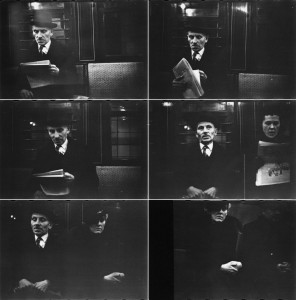Walker Evans photographed people on the New York City subways between 1938-1941. He only published these photographs 25 years later in his book, Many Are Called, which was re-issued in 2004. Read a review about the new edition in the New York Times or listen to a radio interview of the book’s re-release and a related exhibition at the Metropolitan Museum of Art. Then look at some of Evans photographs on the Getty website or on Visualingual’s blog. What do you think of Evans’ clandestine approach to photography? Do you see similarities between the riders’ expressions during the Depression Era to today’s riders?
NPR interview with Met curator Jeff Rosenheim (audio)
Getty Collection of Walker Evans Subway Portraits
Visualingual’s Blog on Walker Evans’ Subway Portraits
The DUE DATE to submit your blog posts for this topic is Sunday, December 15th.





I very well see the same expressions on subway riders faces then and now. Observing the photographs, the riders are just minding their own matters. Each face expression can mean they are going through something or thinking about something at that very moment. I do love the nostalgic look of the photography. I can relate with the photos that it was during The Great Depression.
Evan captured images of people on the subway during the depression era, and they were not published until 25 years later. I find it quite interesting that he waited such a long time until he released them. The images are very intriguing, normal people going on with their daily lives, whether they are on their way to work, coming home from work, or pleasure purposes. What I liked about the photos is that these images are not staged; most photos in this time and in today’s time are mostly set up. These are realistic events, what better way to capture the moment? When one isn’t paying any attention. I do see a lot of similarities between the rider’s expressions during the depression Era to today’s riders. Their facial expressions read that they are tired, unhappy, overworked, some reading the newspaper, engaging in a conversation just like people on the subway today. The clothing is very different, as well as the train itself but the overall image and concept is highly comparable.
Good question about why he waited so long, I believe he thought these photos were intrusive and the passage of time helped ‘soften’ the invasion of privacy.
I find it funny that people 25 years ago have the same facial expressions of people riding the trains today. On the train their is always someone smirking at a newspaper and always someone who looks like their mad at the world because the train was late. And then that would be me behind the camera looking at people wondering what they are thinking therefore if someone was to look at me it would look like i’m in deep thought.
I see the exact same expressions of riders then to now. Riders on the subway now have the exact same look all the time and everyday. There are always people laughing and smiling while reading a newspaper on the train. There are always people mad on the train, o I find this funny how 25 years ago people make the same faces.
Well the photos Walker Evans portray are more of what the city life would be during transportation of subways. Which really have the same faces the people of today make when they are on their way to their destination. It’s very amazing how it just is like a daily thing back then on their expressions due to the great depression back then and compared to today’s where it’s basically the same look people make. I believe Walker just tried to portray a look at the era where the workers seemed to struggle during their time and just capture a photo which seemed to interests him.
Sometimes the best way to see a person is by not engaging them, that’s exactly what Walker Evans did. Going undercover and having a makeshift camera incognito Evans was able to capture people’s everyday habits and emotions undetected. I think Evans approach to taking his photos was very creative, had a large amount of thought and logic behind it. “The guard is down and the mask is off even more than when in lone bedrooms where there’s a mirror faces are naked reposed down in the subway”(-Evans) Other approaches I think had an even larger impact was the releasing of the photos in later years and having anonymous subjects. Seeing the photos one would not think these people were going through a large struggle, although maybe tired from a long day of work they were very dapper. Comparing the era in which taken and present time huge similarities come about. Seeing people go about their day as street performers play right in their ears yet get no praise or attention is no different from today.